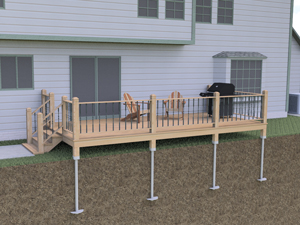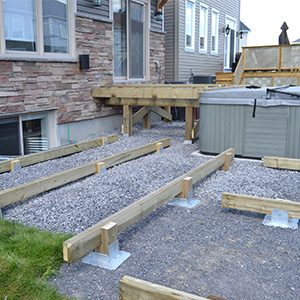Professional Tips for Setting Up Deck Footings to Support Your Outdoor Room
When it involves constructing a deck, one of one of the most crucial components to think about is the installation of proper footings. These grounds are the structure upon which your outside room will rest, providing security and support for years ahead. What precisely does it take to mount deck footings correctly? In this conversation, we will certainly discover expert ideas and strategies that can aid ensure a effective and long lasting deck installation. From choosing the right sort of footings to staying clear of usual errors, we will provide you with the understanding and insights you require to with confidence embark on your deck-building journey. So, let's dive right in and discover the secret to a solid and long-lasting outside space.
Relevance of Correct Deck Grounds
Proper deck footings are necessary for ensuring the stability and longevity of your outdoor room. When creating a deck, it is important to pay interest to the structure on which it will rest. Deck grounds offer the essential support for the entire framework and aid distribute the weight equally - Deck Footings. Without strong and effectively installed grounds, your deck may come to be unpredictable, resulting in safety hazards and expensive repair work.

In enhancement to security, correct deck grounds likewise add to the long life of your outdoor room (Deck Footings). Grounds that are created and created to hold up against the aspects and soil problems in your area will help protect against the deck from changing or working out with time. By guaranteeing the footings are appropriately sized and set up, you can minimize the risk of damage to the deck structure, prolonging its lifespan and decreasing the need for costly repairs or replacements

Choosing the Right Kind Of Grounds
When choosing the ideal sort of grounds for your deck, it is essential to think about aspects such as dirt conditions, local building ordinance, and the general design of your outside room. The kind of footing you pick will certainly play a crucial duty in making certain the security and durability of your deck.
One typical kind of ground is the concrete ground. Concrete footings are suitable for many dirt problems and offer excellent assistance for decks.
In some cases, you may need to use specialized footings, such as heap grounds or deep foundations, if you are constructing a big or multi-level deck. These grounds are designed to disperse the weight of the deck over a larger location, making sure security and avoiding working out or sinking.
Prior to picking a sort of ground, it is vital to speak with regional structure codes and regulations to guarantee conformity. In addition, consider the design and meant usage of your outside area. Elements such as the size, form, and load-bearing requirements of your deck will certainly affect the kind of footing that is most ideal.
Preparing the Ground for Footing Installment
To correctly prepare the ground for footing installation, it is crucial to assess the dirt problems and take needed steps to make sure stability and longevity of the deck. The initial action is to excavate the location where the footings will be mounted.
When the area has actually been dug deep into, the next action is to compact the soil. This can be done utilizing a plate compactor or by using a hand tamper. Compacting the soil assists to eliminate any type of gaps or air pockets, which can bring about settling and instability with time.
After compacting the dirt, it is necessary to lay a layer of crushed rock or crushed rock at the end of the excavation. This will provide water drainage and help to stop water from merging around the footings, which can cause disintegration and instability.
Step-by-Step Guide to Putting Up Deck Footings
After correctly preparing the ground for footing setup, the next action is to start the process of installing deck grounds. This step-by-step overview will certainly offer you with a clear understanding of exactly how to mount deck grounds for your outside room.
Establish the place: Begin by marking the positions of the deck grounds using stakes and string. Ensure that the areas align with the layout and format of your deck.
Dig the holes: Use a post opening digger or an auger to dig the holes for the grounds. The depth and diameter of the openings need to remain in accordance with browse this site regional building codes and the certain requirements of your deck design.
Level the openings: Make use of a degree to make certain that the holes are dug to the correct deepness and are degree with each other. (Deck Footings)
Include crushed rock: Place a layer of crushed rock at the bottom of each opening to boost water drainage and protect against the timber from decaying.
Insert the grounds: Put the footings into the holes, making certain they are level and plumb. Utilize a level and a gauging tape to make sure accuracy.
Secure the grounds: Pour concrete into the openings around the grounds, loading them to the top. Utilize a blog post level to make sure the grounds remain level as the learn the facts here now concrete collections.
Allow time for healing: Let the concrete remedy according to the manufacturer's instructions prior to waging the deck construction.
Usual Errors to Stay Clear Of Throughout Footing Installment
One essential element to consider during the setup of deck grounds is preventing common mistakes that can compromise the stability and long life of your exterior room. While deck footings may feel like a straightforward and straightforward component of the building and construction procedure, neglecting specific factors can lead to costly repair work and possible safety risks down the line.

In addition, disregarding to set up correct water drainage actions can create water to gather around the grounds, leading to rot, decay, and the eventual weakening of the deck's structure. Furthermore, utilizing the incorrect type of footing material or click now failing to adequately protect the footings can compromise their structural integrity.
To stay clear of these errors, it is vital to seek advice from an expert or comply with sector guidelines to make certain proper footing setup. By doing so, you can make certain the stability and long life of your exterior area, supplying a risk-free and enjoyable atmosphere for several years ahead.
Final Thought
In verdict, mounting proper deck footings is vital for the security and durability of your exterior area. By selecting the right sort of footings and effectively preparing the ground, you can guarantee a strong structure for your deck. Complying with a detailed overview and avoiding typical blunders throughout footing setup will further improve the resilience and safety and security of your deck.
Proper deck footings are important for making sure the stability and longevity of your exterior area. The grounds serve as a connection between the ground and the deck, permitting the weight of the deck and its owners to be spread evenly into the dirt.One usual type of ground is the concrete ground. Put the grounds: Put the footings into the openings, making sure they are degree and plumb. Protect the footings: Pour concrete into the holes around the footings, loading them to the top.